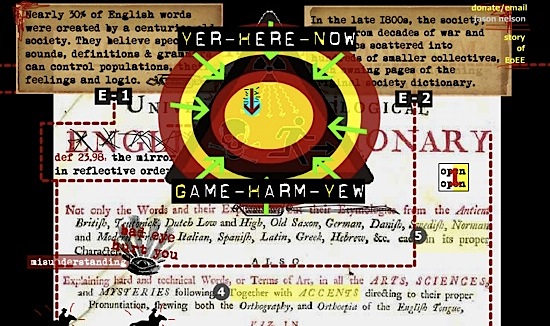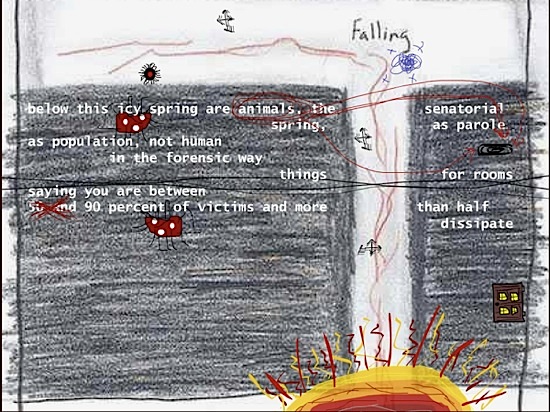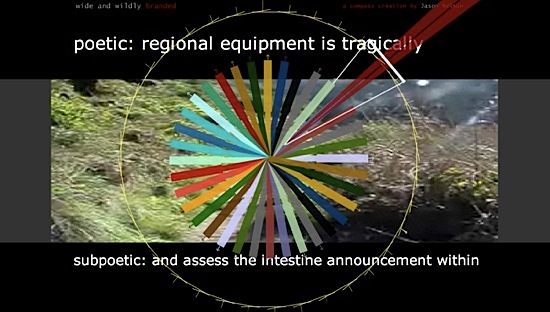Spear Talks: Jason Nelson

Jason Nelson is a digital and hypermedia poet and artist. If you’re not acquainted with digital work, you likely have questions regarding what it is. If you are acquainted with digital work – well, you still have questions.
Obviously, there are distinct differences between art made with technology and art made with paint. For one, as Jason points out, “With an art gallery, you get to see nice smelling people experience your work. With net artwork, you sit in your underwear, drinking dark tea in a jar and eating fish sticks, while watching thousands stream into your site by pressing refresh on your statistics page.” However, there are distinct similarities, too – ones that bind the world of code to the world we live in as discernibly as Facebook or Flickr.
Like traditional art, the secret to the digital art experience lies in the telling, in the understanding, and in the experience. But for Jason, a US-born Aussie who is known for building award-winning games that weave coding into poetry (and vice versa), the secret to the digital art experience takes on one more facet: the playing.
On with the show:
Joshspear.com: You’re described as, among other things, a digital and hypermedia poet. What exactly does that entail?
Jason Nelson: Excuse me if I break into preachy mode, but this whole nomenclature, the weaving of words to categorize and label is both necessary and treacherous. If left alone in a field, with a long extension cord and a waterproof laptop, I’d just say I try to link the back of my brain to what happens on the screen. And yet, we need nametags for others to say hello. So, I’m called a digital poet. As a digital poet I play with texts, with language. And by language I mean more than just words. All symbols, sounds, movements, images and interactivity are forms of communication and thus possible Lincoln Logs for a poet with a Peter Pan complex.
So I write with code and software, capture devices (cages and cameras) cobbling together all these multimedia gizmos into a poem of sorts. Does that make any crap hell damn sense?
JS: It does make crap hell damn sense, absolutely. What’s harder for me – and probably a lot of people – to comprehend is the connection between code and creativity. A lot of people view coding as cold, almost like math, so using it with the intent of creating something deeply artistic is interesting to fathom.
Jason Nelson: It is strange trying to satisfy, engage and otherwise stimulate both sides of your brain – the logical and emotional, the analytical and creative – when I create these net artworks. I, and indeed most others working creatively with complex software and code, see myself as a digital Dr. Frankenstein. I take bits and pieces of code and software tricks, I gather them like human parts, boxes of hands, shelves of eyeballs and hearts, and then attempt to cobble them together.
When you are entirely self-taught, and rarely collaborate, you spend heaps of time scouring the net or code answers and possibilities. So what you would see if you cracked open my works is a mess of loosely tethered actionscript, sometimes in various different languages and versions of flash.

JS: Oil paint is pretty much the same beast today as it was in the Renaissance. Technology, on the other hand, progresses pretty quickly. What has it been like to work within a medium that’s always on the move?
JN: As a digital artist, dealing with the ever changing world of technology is both exciting and terrifying. All contemporary art is to some extent driven by changes in materials, in gizmos, in software and possibilities. So when a new Flash version comes around, or a cool new devices become popular there is a rush of new ideas, new possibilities. The danger with that (and with much of new media) is that new techniques don’t make for good art, interesting expression, digital poetry. Many artists are so consumed with clean design and good code and fancy new tricks that they forget to create interesting art. There is also the problem or learning to work in new platforms and software. It’s like going back to school ever few years to learn and relearn and unlearn. I find the best solution is to play leap-frog, to get behind the curve, and then suddenly jump ahead, ignoring all the steps in between.
JS: Tell us about one of the digital poems you’ve created – what was your inspiration behind it, and what question does it explore (assuming it in fact explores one)?
JN: I’m always shocked that somehow I’ve kinked together over 30 digital critters for the net. Some are embarrassingly average, poor crafted from the easiest of software tricks. And others still surprise me with their originality and ability to force out thought and surprise, harsh and glowing reactions from the readers/players. There are a few creations that have captured a few million eyes/fingers, gone viral around the net, into hard drives and forums and a weirdly wide range of sites. The first of those was a work called “game, game, game and again game” and its sequel, “I made this. you play this. we are enemies.” They’re digital poems, platform games, hand drawn madness hybrids, supposedly unlike anything before them and often cited as an example of an indie art game. I built/birthed that game at an outdoor coffee shop, surrounded by late night party kids a few minutes walk from the beach in the Gold Coast of Australia. It’s a chaotic place with snippets of drunken conversation, strange and sudden sea breeze driven storms and the constant restless clash of tourists and locals.
I suppose they were inspired by two interests: wanting to use a commonly known and immersive interface (i.e.; the Mario style game engine) and my fascination with finding sketches and seemingly random notes in library books. We all have our own ways of marking up the world around us, these private conversations between a pencil, paper and whatever the heck is roaming in our imaginations. So the games use these two elements to explore various types of religion or belief structures, from “faith” to “real estate” to “pharmaceuticals,” etc.
JS: To be described as “avant-garde” is a double edged sword. On one hand, people don’t always fully understand what you’re doing, which rightly creates some mystery and intrigue. On the other hand – people don’t always fully understand what you’re doing. How important do you consider the role of comprehension in art as a whole?
JN: Art and comprehension? Hmm… do you remember your art/literature classes in primary and high school? We are taught from that early age to see art with a nearly scientific filter. To break it apart and puzzle out its meanings and arty equations. My guess is that for many that forced analysis has sucked out the joy and mystery and mental play interesting artworks should inspire. Is there a meaning, a specific goal in mind when I create something? Of course there is. But I would rather readers/players explore/play/get lost in the world of my creations, to see these odd net artworks as tense and thin lines of imagination held loosely by ideas. To play.
Or – ok – how about this: I’ve had a few thousand emails grace my inbox, with a large number of those saying that they loved the artwork, but they weren’t sure why. And even those that hate it, hate it because it breaks their brain away from easy to digest parameters. There is this breakfast cereal I enjoy for lunch here in Australia. It’s filled with all this crazy crap, as if the remainders of a dozen other food products were poured into the box. I enjoy it, for reasons that are vague and conflicting. And that makes me happy.
JS: You’ve gotten some cool awards – like the 2009 Webby for Weird! Was that award for a specific game or piece?
JN: Not to be a tall poppy (an Australian phrase referring to the dangers of ego strutting) 2009 was a good year with four international awards and loads of critical niceness. And, yes I won a webby as well for my art portal (and all its many artworks) secrettechnology.com, and yes in the weird category. Although honestly, I’ve never felt my work was all that weird. But then I suppose it’s always those creations that seem so normal to the creator that appear most weird to everyone else.
It’s always a rush to see people write about your work or win an award, but with the net it’s a candy bar high. A quick burst followed by a slightly sick and sleepy feeling. With an art gallery, you get to see nice smelling people experience your work, have these fancy drunken wine and cheese shindigs, and be caressed by curators and critics. With net artwork, you sit in your underwear, drinking dark tea in a jar and eating fish sticks, while watching thousands stream into your site by pressing refresh on your statistics page. In the “art should transform culture” net art scores high marks, but for the creator/artist web audiences are a strangely abstract idea, as it’s more about the artwork than the artist.
JS: I love that comparison between gallery viewings and net viewings – you can certainly extend that odd experience of solitary interaction into all areas of the social web. It IS a very different experience though – do you ever hope to see your work in a gallery setting?
My work does end up in physical spaces, in galleries around the world. And on the rare occasion I can actually make the trip from this dry southern continent to Europe or the Americas or wherever else my work ends up, I’m always struck by the difference in people’s engagement. I wish I could embed a camera into my net-based creations and secretly watch people play while they drink chocolate milk and wear warm and fancy hats. But my server stats show that most or at least many play for ten or twenty minutes, sometimes for hours if they explore my other works. And yet in a gallery, the usually walk by or briefly play/move/read before moving on. Even immersive artworks, with cool physical interfaces don’t get more than a few minutes of attention. I love galleries and big public spaces by the way. I just think that in public people tend to want to watch, be a passive or group-centred audience. Rarely do we riot by ourselves.
Having said that, I do think we will eventually have more galleries that embrace this semi-solitary play. Imagine those lovely gaming rooms in Taiwan or Singapore, where a half a hundred computers hum away, heaps of kids huddled around playing, drinking cola spiked with cough syrup, chattering away at the scribbles and strange texts.
JS: The kind of person that really embraces your work – does that person seem to fit a certain archetype? Or do you experience all kinds?

JN: Well, the first audience is usually the literary/digital poetry, literature/art community, academics or closely associated mostly. They immediately “get” my work and invite me to say odd things in auditoriums for students who come for extra marks. But once the artwork is released into the big broad net, the audiences are really diverse. I’ve had work talked about on car enthusiasts forums, get emails from soldiers serving in the middle east, gaming portals, art journals, major newspapers in Spain, Germany, Philippines, France – even had some webmaster for a bunch of p@rn websites including links to my work. So there doesn’t seem to any particular audience. And again the reactions are either love or hate it – not much in between.
JS: One form of language that your work has to do without – given its techie nature – is body language. That’s such a fascinating one – do you ever miss the possibility of creating something from that interaction?
JN: Yes, yes, yes. I think to some extent I’ve become addicted to the immediacy and large numbers of the net. And yet I do miss the outside world, the wind and the buildings and the crowds. So my goal over the next year is to create some works outside the webby web.
For example, I so very much want to create for phones, small scale and portable artworks for people riding the train to work. Or GPS fascinates me, linking places to digital artworks has loads of allure. I’ve also developed some ideas and code starts for an artwork that uses the digi-cam as an interface device. The barrier to creating these more physical artworks is the learning curve. I don’t know how to code for a phone or GPS device, so as an digital artist you either have to collaborate or spend immense amounts of time learning new technologies. Heck if I had my druthers…I’d make robots.
JS: Can you tell us about what your latest or future projects? What’s next for you?
JN: As for current works – the largest and most enticing is a new art game. The fourth in my virally successful series of art games has level designs built on historical letters and documents, including the diagram for NASA’s moon landing, an early, pre-super rich letter from Bill Gates, and pages from James Joyce, Dadist posters and a 1918 influenza letter. With strange stories and drawings and all manner of goodness.
Another curious creature is a news feed visualizer that turns the language of the news into a hand drawn cityscape, called Emotional Cities, as well as a range of other smaller digital poems I build to fend off malaise.
